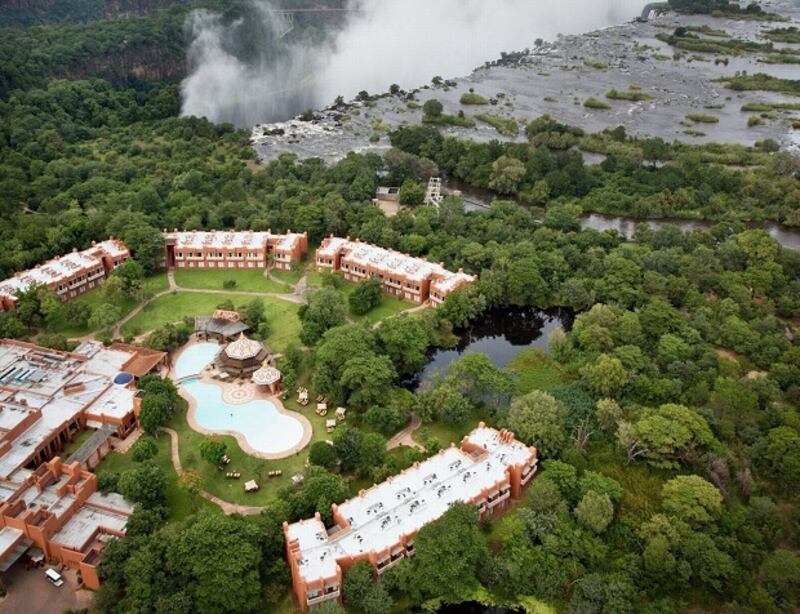Set back from a runway in Livingstone in Zambia, there's a contraption that looks like a tiny, two-person sidecar with paraglide attached, ready for me to step in. Frankly, it looks like a contender in the Wacky Races, the old animated series famed for its outlandish transportation methods. Yet it's in this microlight that I'm expected to fly over the Victoria Falls, the world's largest waterfall.
I’ve already seen the unforgiving might of the falls. Not a week before, arriving into Zambia, my first glimpse of the Natural Wonder of the World is by car, over the arched Victoria Falls Bridge. Photographers can try, but there’s no picture in the world that could adequately convey the magnitude of the falls as it feels in person: there’s the power of its roar, the breadth that continues until it’s obscured rather than curtailed, the sheer volume of water gushing between the rocks that jut out, the plumes of spray thrown up higher than the 350m falls itself. No wonder the indigenous Lozi people call it Mosi-oa-Tunya – or, “the smoke that thunders”.
So, forgive me for my nervousness about viewing it from above, with thin air between myself and the gaping gorges below.
Louis Geldenhuys, a pilot on a break, encourages me to take the flight. “People always ask me, do I get tired of flying over the Victoria Falls,” he says, smile as wide as they come. “The answer is no. I could never tire of it. It’s like looking at a camp fire, there’s something so mesmerising about it.”

Approaching my waiting microlight, I also comfort myself with stone-cold facts: flying in it is statistically as safe as horse riding; in the rare chance the engine fails, the pilot can still steer the wings as if it were a paraglide.
Seconds later, the pilot, Pascal, and I are metres above the ground – and the poor guy – I’m screaming in his ear out of sheer exhilaration. He encourages me to stretch my arms out to feel the freedom, and so the wind ruffles past me as we smoothly swoop left for a view of the ground that’s turning smaller and smaller; the trees of the nearby Mosi-oa-Tunya National Park begin to look like broccoli, and the glistening Zambezi River comes into view. Then we see the falls from behind – the spray is so high we have to climb further into the sky to avoid it. When we’re in front, I ascertain our incredible height from how tiny it looks, and it’s at this point I shed a tear – partly as I marvel at the beauty of this natural phenomenon, partly out of overwhelming emotion I can’t otherwise release without deafening Pascal, but also at the feat of engineering that allows this experience.
Livingstone
Marking the border between Zimbabwe and Zambia, the Victoria Falls was so named by Scottish explorer David Livingstone after the ruling queen in 1855. His own name is given to both the largest island in this part of the Zambezi, and the nearby Zambian town that acts as a base for those visiting the attraction – though during the off season, in which I visit, the impact of tourism is largely hidden. Save for a coffee shop, the city streets feel untouched by western trappings as people go about their daily business of buying and selling, many with placid babies slung across their chest.
Even the falls itself is less hustley and bustley than I’d anticipated. Between the vantage points in Zimbabwe and Zambia, it receives around 600,000 visitors a year – a fraction of the visitors to Niagara Falls in Canada (30 million) or Iguazu Falls in Argentina (1.5 million).

The most unexpected aspect here, however, is Victoria Falls’s accessibility. After spending an adulthood believing that a visit needed the logistical prowess of a military commander, once you’re in Livingstone – itself a 90-minute flight from Johannesburg in South Africa – it turns out it’s easily possible to witness its power by train, plane, on foot, from below, via a bungee jump, rope swing and by boat, depending on your adrenalin preferences.
It helps that I’m staying at its adjacent hotel, the Avani Victoria Falls Resort. It takes 90 seconds exactly from the perimeter of the hotel to a magnificent view of the falls from within its national park. And when I realise that unlimited entry is included for residents, I’m back and forth like a yo-yo, just because I can.
The first time, I return squelching and soaked – the winds cause the immense spray to throw itself directly at those viewing it from the park. The second time is at dawn; I wait until first light and then step past the zebra, impala and baboons roaming the hotel grounds, and armed with a poncho, enjoy some quality one-to-one time with the falls as the first visitor in the park.
It’s an intimate, spiritual experience, and if I didn’t understand why the Lozi people believe it to be a sacred site, I do now. And most certainly after my third visit: it’s on this sunny day that I catch a glimpse of the rainbows, which often form as the African sun catches the mist, as if the scene needed to be any more magical. On one side, there’s a double rainbow. On the other, there’s three-quarters of a circle shining in seven colours – a natural phenomenon that’s as humbling to see as the Northern Lights.
Livingstone wrote of the Lozi’s religious practices: “They chose their places of prayer within the sound of the roar of the cataract, and in sight of the bright bows in the cloud...The play of colours of the double iris on the cloud, seen by them elsewhere only as the rainbow, may have led to the idea that this was the abode of Deity.” It truly is heavenly.
A river run
The Zambezi River, which broadly follows Zambia’s border with Angola to west and Zimbabwe to the south, before flowing into the Indian Ocean in Mozambique, provides a number of alternative ways to experience the falls. Nerves already shot, I de-scope white-water rafting and the Devil’s Pool, where sunbathers can relax in a natural rock pool at the very top of the falls, peering over the edge to the drop if they’re brave enough.
My interest is piqued, however, by a river cruise, which takes place on the upstream side of the falls. I always wondered whether these waters would be eerily calm before plummeting with such great ferocity, or whether it was a grade 6 rapids situation. First of all, it’s time to crack open a cold, sweating can of Mosi, the local beer, and view some of the wildlife along the river.
As we set off, a flock of vibrantly-feathered white-fronted bee-eaters dart towards their nest on the river banks; later, African kingfishers, loads of igrets, jarkartas, marabou storks come into view. But it’s the regal elephants, elusive crocodiles and the monstrous hippos – grumpy and dangerous – that have us rushing, cameras outstretched, to one side of the titling boat.
The hippos are incredible to see in the flesh; unhappy about being ogled by a number of boats, one stretches its impossibly large mouth wide open, baring its stumpy teeth and fleshy pink insides. They’re interesting enough to watch for hours, but the dusky skies cause us to head back towards the hotel dock by river. With some skilled captaining, we navigate through choppy but manageable waters (that’s my answer then) until we step onto the grounds of Avani’s adjacent sister hotel, just as the sun sets in a purple haze over the spray of the river.
The last way to view the falls is in style with a sunset train experience – a decadent finale to an unforgettable visit. The Royal Livingstone Express is a restored 1930s steam engine with interiors all deep crimson and shiny mahogany, in which premium wines from South Africa are served before a fine dining experience that by rights shouldn’t be as delicious, given the captive audience.
During the journey, a prominent local regales us with stories about Zambia’s history, including its Irish missionaries and publicly-minded settlers (more than 800 Irish citizens still live there), and we’re given time to hop off at Victoria Falls Bridge, for the obligatory selfies with the mighty falls in the background. It’s my last look at the falls for the trip, so I forgo the photo-op to gaze a little more at its wonder, trying hard to memorise each jutting-out rock formation and flow idiosyncrasy like the lines of a loved one’s face.
After admiring it from every which way and still unable to take my eyes off it, I can only agree with Geldenhuys: Victoria Falls is truly mesmerising.
Shilpa Ganatra was a guest of Avani Victoria Falls Resort, the closest hotel to Victoria Falls. Its 212 rooms and suites start at €165 per night excluding VAT. See www.avanihotels.com to book.




















